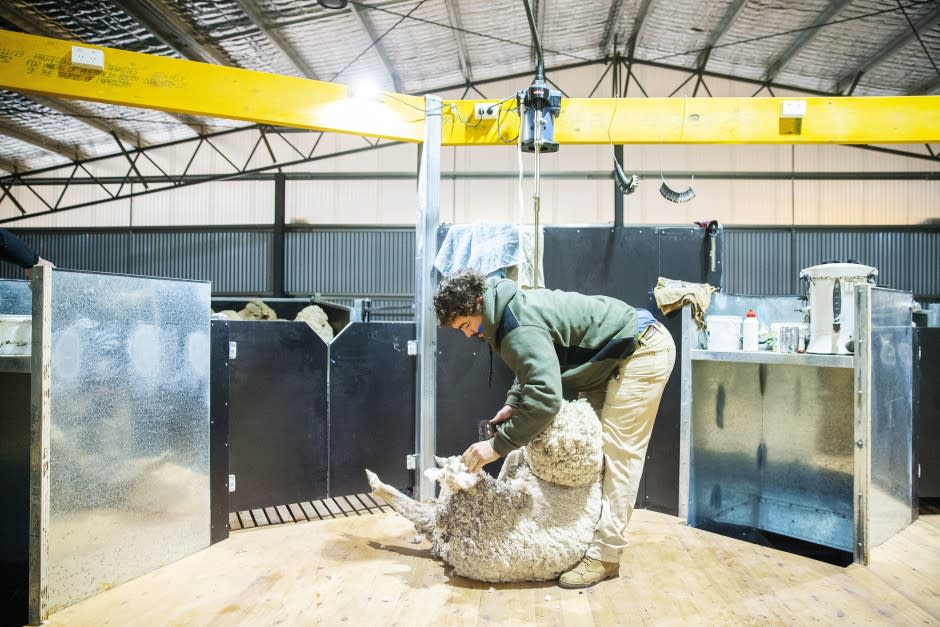China-Australia relations: Beijing raises wool import quota, but move not seen as sign of warming ties

Undeterred by the strong Australian dollar, Chinese buyers are snapping up Australian wool after Beijing lifted this year's wool import quota - a rare positive sign amid frayed relations between the two countries.
The development sparked hopes in some quarters that it could signal the start of a recovery in relations, but some analysts have downplayed its broader significance, noting that China was just complying with the terms of the two countries' free-trade agreement.
In the year's first Australian wool auctions, held last week, China textile makers and wool processors led the way in purchases despite a strengthening Australian currency, according to wool-supply-chain research group Australian Wool Innovation (AWI).
Get the latest insights and analysis from our Global Impact newsletter on the big stories originating in China.
On November 1, the conversion rate was roughly 4.7 yuan to the Australian dollar, and the rate has gradually increased to 5 yuan, meaning purchases valued in Australian dollars require more yuan.
There had been concerns that exports of wool could be dampened by the Australian dollar's strong rise, with Australian goods being more expensive for foreign buyers, but there were no signs of weaker demand in the lead-up to last week's auctions, AWI said in a note.
"On the Chinese processors' side, the current lack of the usual strong buying from Europe and the [Indian] subcontinent in this sector has opened up big export opportunities for them in tops and yarn supply," AWI said. "Tops" are the semi-processed intermediary fibres between raw wool and clothing, ready for spinning.
"Traders dominated the buyer lists this week, but were ably supported by the Chinese top makers."
The positive news comes after China's Ministry of Commerce announced this month that it had lifted the import quota on Australian wool to 38,288 tonnes for 2021 from 36,465 tonnes last year.
China has kept to its agreement of raising the duty-free, wool-import quota for Australia by 5 per cent each year from 2018, until it reaches 44,324 tonnes in 2024, in line with the China-Australia Free-Trade Agreement, even as tensions continue to simmer between the two countries.
The Chinese quota is in addition to a World Trade Organization quota of 287,000 tonnes, on which China can charge only a 1 per cent tariff. If wool exceeding this level is shipped to China, then a 38 per cent tariff kicks in, although historical volumes have never come close to that limit.
What's happened over the last nine months in China-Australia relations?
China and Australia this week entered the 10th month of their political and commercial conflict. After Australia pushed in April for an international investigation into the origins of the coronavirus without consulting Beijing, China unofficially blocked imports of products such as cotton, log timber and coal. It also imposed anti-dumping duties on Australian wine and barley.
Wool has been in a particularly vulnerable position amid rising trade tensions, with many analysts concerned it could be one of China's next targets, due to Australia's reliance on China for its export sales.
During the 2019/20 financial year that ended on June 30, 79 per cent of Australia's wool exports went to China, with the trade averaging about 78 per cent between 2017 and 2019. China, too, is reliant on Australian wool, purchasing about 75 per cent of its wool imports from down under.
While there is mutual dependency at the moment, Australia's exports could still be compromised due to limited alternative markets as China pushes for self-sufficiency in the fibre as part of its broader goals involving food security and import diversification, Scott Waldron, a senior research fellow at the School of Agriculture and Food Science at the University of Queensland, said in a study late published last year.
But the Australian Bureau of Agricultural and Resource Economics and Sciences was more sanguine in its quarterly update in December, saying both countries would be disadvantaged if the wool trade were targeted.
Andrew Whitelaw, an agriculture analyst for Thomas Elder Markets, was confident that strong mutual dependence "reduces the chances of wool being targeted by a diplomatic spat", but he cautioned that a lift in the quota was not a sign that the relationship between the two countries had improved.
"Whilst it is good to see China sticking to their agreement, this should not be misconstrued as a thawing of our relationship. They are sticking to their understanding, and that is all," he said in a note.
While a lift in the quota is a good sign, the key concern for Australia this year is lower wool production amid drought conditions and fewer sheep being sheared.
This article originally appeared in the South China Morning Post (SCMP), the most authoritative voice reporting on China and Asia for more than a century. For more SCMP stories, please explore the SCMP app or visit the SCMP's Facebook and Twitter pages. Copyright © 2021 South China Morning Post Publishers Ltd. All rights reserved.
Copyright (c) 2021. South China Morning Post Publishers Ltd. All rights reserved.
